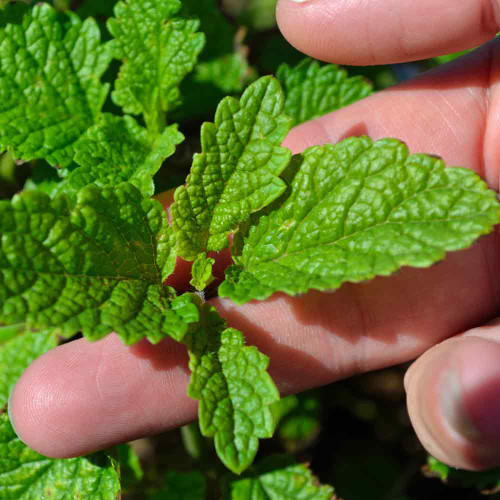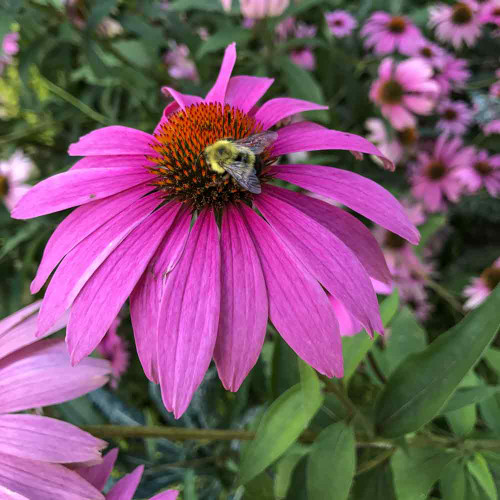Description
Lemon Bee Balm - A Citrus-Scented Delight for Your Garden
As you walk through your garden, you brush against the velvety leaves of Lemon Bee Balm, releasing a burst of refreshing citrus fragrance. This captivating North American native wildflower, also known as Lemon Mint or Purple Horsemint, is a delightful addition to any garden, large or small. Its vibrant lavender to pink flowers attract a flurry of pollinators, bringing life and beauty to your outdoor space. Easy to grow and adaptable to various conditions, Lemon Bee Balm is a rewarding choice for any home gardener.
Details
Lemon Bee Balm captivates with its delightful scent. Its distinctive square stems, a hallmark of the mint family (Lamiaceae), are clothed in narrow, serrated leaves that release a burst of lemony fragrance when crushed. From late spring through summer, and even into fall with consistent watering, the plant comes alive with tiered, globular clusters of tubular flowers. Perched atop white or lavender bracts, these blooms create a visually stunning display. Reaching a height of 12-30 inches and spreading 9-12 inches wide, Lemon Bee Balm lends a touch of wild elegance to borders, naturalized gardens, prairies, and meadows.
This hardy perennial (USDA Hardiness Zones 2-11) thrives in sunny spots with well-drained soil. Lemon Bee Balm's drought tolerance makes it an excellent choice for busy gardeners and those in drier regions. Though it may become somewhat aggressive in ideal growing conditions, its self-seeding habit ensures its continued presence in your garden yearly, even if individual plants are short-lived (annual, biennial, or short-lived perennial). It also flourishes in containers, making it a versatile option for balconies and patios.
Lemon Bee Balm is a true pollinator magnet, attracting a variety of bees, including bumblebees, honeybees, and native species, as well as butterflies like Swallowtails, Monarchs, and Painted Ladies. Hummingbirds like the Ruby-throated and Black-chinned are also drawn to its nectar-rich blooms. By supporting these essential pollinators, Lemon Bee Balm plays a vital role in the health of your garden ecosystem, enhancing its productivity and adding a vibrant touch of nature.
History
Native to the central and southern United States and Mexico, this plant has a long and fascinating relationship with indigenous peoples. They recognized its value long before European settlers arrived, using it for medicinal and culinary purposes. The Oswego people, a tribe from the Great Lakes region, brewed a refreshing tea from its leaves. This "Oswego tea," as it was known, wasn't just a tasty beverage; it was believed to have calming and digestive benefits and was even used to soothe colds and coughs. Upon discovering this delightful brew, European settlers readily adopted it, eventually introducing it back to Europe.
The Monarda genus, encompassing Lemon Bee Balm, is named for Nicolás Monardes, a 16th-century Spanish physician and botanist. Monardes was pivotal in enlightening others about New World medicinal plants throughout Europe. His position as physician to King Charles V of Spain and at the Casa de Contratación in Seville provided access to extensive botanical information brought back by explorers. His 1574 publication, "Historia medicinal de las cosas que se traen de nuestras Indias Occidentales," a groundbreaking work on medicinal plants including tobacco, sassafras, and balsam, significantly advanced European understanding of American flora, earning him the honor of having the Monarda genus named after him by Carl Linnaeus.
While we don't have a precise date for when Lemon Bee Balm first arrived in Europe, it likely traveled alongside other Monarda species after the 16th century. Its spread across the continent probably followed the well-trodden paths of botanical exchange, passing through monasteries, royal gardens, and the collections of passionate plant enthusiasts. Its enduring appeal explains its continued presence in gardens today, connecting us to its indigenous roots and intriguing history.
Uses
The leaves of Lemon Bee Balm offer a refreshing citrus flavor to teas, salads, and other culinary creations. They can be used fresh or dried. Traditionally, the leaves were used to make a soothing balm for bee stings and a refreshing beverage known as Oswego tea.
Companion Planting
Beneficial Companions - Tomatoes (repels hornworms, improves flavor), cucumbers (attracts beneficial insects), peppers (attracts pollinators, repels aphids), other flowers (coneflowers, black-eyed Susans, yarrow), herbs (basil, rosemary, oregano).
Antagonistic Plants - Invasive plants (barberry, burning bush, English ivy), heavy feeders (corn, melons, beets), shade-creating plants.
Planting and Growing Tips
For a thriving Lemon Bee Balm patch, sow seeds in either fall or early spring, lightly raking them into the topsoil. This aromatic herb flourishes in full sun to light shade, appreciating well-drained soil. Amend the soil with organic matter at planting time to provide a nutrient-rich foundation. Space plants approximately 12 inches apart to ensure proper air circulation, which helps prevent issues like powdery mildew. Regularly deadhead spent flowers to encourage continuous blooming throughout the season. Cut back the stems in the fall to prevent the plant from becoming woody. A layer of mulch helps retain soil moisture, suppresses weeds, and adds a polished look to your garden beds. While generally a hardy plant, Lemon Bee Balm can be susceptible to powdery mildew, particularly in humid environments. Providing ample spacing for good air circulation and avoiding overhead watering are crucial preventative measures.
Harvest Tips
The leaves of Lemon Bee Balm are the prized part of the plant for harvesting, offering a refreshing citrusy flavor perfect for culinary and medicinal applications. For the best flavor, harvest the leaves in the morning after the dew has dried but before the day's heat intensifies. Ideally, harvest when the small flowers have just appeared or even slightly before, as the leaves tend to become bitter after the plant flowers.
Learn More
- How to Grow Citrus Flavors in Your Garden
- Planting A Pollinator Feast
- Edible Flowers From Garden to Gourmet - Heirloom Varieties for Every Kitchen
From the soil to the seed to the food you eat - we'll help you grow your best garden!















